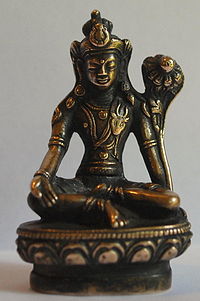Khasarpani: Difference between revisions
(Himalayan Art) |
No edit summary |
||
| Line 1: | Line 1: | ||
[[Image:Avalokitestvara Khasarpani.JPG|thumb|200px|Avalokiteshvara Khasarpani, 17th century bronze, Tibet; 6.75cm]] | [[Image:Avalokitestvara Khasarpani.JPG|thumb|200px|Avalokiteshvara Khasarpani, 17th century bronze, Tibet; 6.75cm]] | ||
'''Khasarpani''' (Skt. ''Khasarpaṇi''; [[Wyl.]] ''kha sar p'a Ni'') — a form of [[Avalokiteshvara]] with one face and two hands. His right hand is in the [[mudra of supreme generosity]], and the left is often in the [[mudra of teaching the Dharma]] and holds a lotus blooming at the level of his left ear. Iconographically, Avalokiteshvara Khasarpani is often indistinguishable from the seated form of the meditational deity called [[Amoghapasha]] (Unfailing Lasso). They are often conflated in both Sanskrit and Tibetan texts and practices. | '''Khasarpani''' (Skt. ''Khasarpaṇi''; Tib. ཁ་སར་པའ་ཎི་, [[Wyl.]] ''kha sar p'a Ni'') — a form of [[Avalokiteshvara]] with one face and two hands. His right hand is in the [[mudra of supreme generosity]], and the left is often in the [[mudra of teaching the Dharma]] and holds a lotus blooming at the level of his left ear. Iconographically, Avalokiteshvara Khasarpani is often indistinguishable from the seated form of the meditational deity called [[Amoghapasha]] (Unfailing Lasso). They are often conflated in both Sanskrit and Tibetan texts and practices. | ||
The great [[Tertön]] [[Chokgyur Dechen Lingpa]] discovered an image of Avalokiteshvara Khasarpani made from a bone of [[Yeshe Tsogyal]] as the sacred body representation for his ter ''Padma Tsuktor''. This image was last known to be in the treasury of [[Rumtek Monastery]] during the lifetime of the 16th Gyalwa [[Karmapa Rangjung Rigpé Dorje]]. | The great [[Tertön]] [[Chokgyur Dechen Lingpa]] discovered an image of Avalokiteshvara Khasarpani made from a bone of [[Yeshe Tsogyal]] as the sacred body representation for his ter ''Padma Tsuktor''. This image was last known to be in the treasury of [[Rumtek Monastery]] during the lifetime of the 16th Gyalwa [[Karmapa Rangjung Rigpé Dorje]]. | ||
Latest revision as of 04:52, 1 March 2018

Khasarpani (Skt. Khasarpaṇi; Tib. ཁ་སར་པའ་ཎི་, Wyl. kha sar p'a Ni) — a form of Avalokiteshvara with one face and two hands. His right hand is in the mudra of supreme generosity, and the left is often in the mudra of teaching the Dharma and holds a lotus blooming at the level of his left ear. Iconographically, Avalokiteshvara Khasarpani is often indistinguishable from the seated form of the meditational deity called Amoghapasha (Unfailing Lasso). They are often conflated in both Sanskrit and Tibetan texts and practices.
The great Tertön Chokgyur Dechen Lingpa discovered an image of Avalokiteshvara Khasarpani made from a bone of Yeshe Tsogyal as the sacred body representation for his ter Padma Tsuktor. This image was last known to be in the treasury of Rumtek Monastery during the lifetime of the 16th Gyalwa Karmapa Rangjung Rigpé Dorje.
External Links
- The Life of Chokgyur Lingpa, by Orgyen Tobgyal Rinpoche, Rangjung Yeshe Publications. Download as PDF
- Himalayan Art